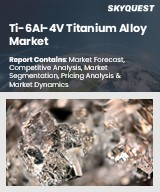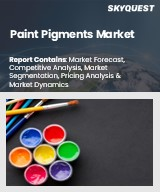
|
시장보고서
상품코드
1623752
티타늄(Ti) 금속 시장 : 규모, 점유율, 성장 분석, 제품 유형별, 최종 이용 산업별, 지역별 - 산업 예측(2025-2032년)Titanium (Ti) Metal Market Size, Share, Growth Analysis, By Product Type (Alpha & Near-alpha Alloy, Alpha-beta Alloy), By End-Use Industry (Aerospace & Defense, Chemical & Process Industry), By Region - Industry Forecast 2025-2032 |
||||||
세계의 티타늄(Ti) 금속 시장 규모는 2023년에 265억 달러로 평가되었고, 2024년 282억 2,000만 달러에서 2032년에는 467억 1,000만 달러로 성장해 예측 기간(2025-2032년) CAGR은 6.5%를 나타낼 전망입니다.
세계의 티타늄(Ti) 금속 시장은 다양한 분야에서 수요 증가를 주요인으로 하여 현저한 성장을 이루고 있습니다. 특히 많은 티타늄의 경량성, 내식성, 고온 안정성은 항공우주 산업과 방위 산업에 이상적이며 우주선과 항공기 부품에 주로 사용됩니다. 가장 일반적인 합금인 6Al-4V는 그 강도와 내식성에서 선호됩니다. 요구를 충족하기 위해 수입에 크게 의존하고 있으며 항공우주 및 방어 부문에서 지배적인 위치를 강조합니다.
목차
서문
- 조사의 목적
- 조사 범위
- 정의
조사 방법
- 정보 조달
- 2차 데이터와 1차 데이터의 방법
- 시장 규모 예측
- 시장의 전제조건과 제한
주요 요약
- 세계 시장 전망
- 공급과 수요 동향 분석
- 부문별 기회 분석
시장 역학과 전망
- 시장 개요
- 시장 규모
- 시장 역학
- 성장 촉진요인과 기회
- 성장 억제요인과 과제
- Porter's Five Forces 분석
주요 시장 인사이트
- 중요 성공 요인
- 경쟁도
- 주요 투자 기회
- 시장 생태계
- 시장의 매력 지수(2024년)
- PESTEL 분석
- 거시경제지표
- 밸류체인 분석
- 가격 분석
- 공급망 분석
- 사례 연구 분석
- 특허 분석
세계의 티타늄(Ti) 금속 시장 규모 : 제품 유형별
- 시장 개요
- 알파 및 니어 알파 합금
- 알파베타 합금
- 베타 합금
세계의 티타늄(Ti) 금속 시장 규모 : 최종 이용 산업별
- 시장 개요
- 항공우주 및 방어
- 화학 및 공정 산업
- 에너지 및 전력
- 담수화
- 기타
세계의 티타늄(Ti) 금속 시장 규모 : 지역별
- 북미
- 미국
- 캐나다
- 유럽
- 독일
- 스페인
- 프랑스
- 영국
- 이탈리아
- 기타 유럽
- 아시아태평양
- 중국
- 인도
- 일본
- 한국
- 기타 아시아태평양
- 라틴아메리카
- 브라질
- 기타 라틴아메리카
- 중동 및 아프리카
- GCC 국가
- 남아프리카
- 기타 중동 및 아프리카
경쟁 정보
- 상위 5개사 비교
- 주요 기업의 시장 포지셔닝(2024년)
- 주요 시장 기업이 채용한 전략
- 시장의 최근 동향
- 기업의 시장 점유율 분석(2024년)
- 주요 기업의 기업 프로파일
- 기업 개요
- 제품 포트폴리오 분석
- 부문별 점유율 분석
- 수익의 전년대비 비교(2022-2024년)
주요 기업 프로파일
- AMG Advanced Metallurgical Group NV
- The Chemours Company
- Tronox Holdings, PLC
- Lomon Billions Group
- Titanium Metals Corporation
- Ust-Kamenogorsk Titanium and Magnesium Plant JSC(UKTMP)
- Allegheny Technologies Incorporated(ATI Metals)
- Toho Titanium Co. Ltd.
- VSMPO-Avisma
- Cinkarna Celje D.D.
- Evonik Industries AG
- Tayca Corporation
- Iluka Resources Limited
- Ishihara Sangyo Kaisha, Ltd.
- Shanghai Jiuta Chemical Co. Ltd.
- Grupa Azoty SA
- Swastik Interchem Private Limited
- Kish Company, Inc.
- Osaka Titanium Technologies Co. Ltd.
- American Elements
결론과 권장사항
KTH 25.01.23Global Titanium (Ti) Metal Market size was valued at USD 26.5 billion in 2023 and is poised to grow from USD 28.22 billion in 2024 to USD 46.71 billion by 2032, growing at a CAGR of 6.5% during the forecast period (2025-2032).
The global Titanium (Ti) Metal Market has experienced remarkable growth, driven largely by rising demand across various sectors. As the ninth most abundant element, titanium is often processed into various forms, including sheets, bars, and tubes, which are utilized in numerous applications. Notably, titanium's light weight, corrosion resistance, and high-temperature stability make it ideal for aerospace and defense industries, where it is predominantly used in spacecraft and aircraft components. The most prevalent alloy, 6Al-4V, is favored for its strength and resistance to corrosion. The United States accounts for approximately 28.3% of the global titanium market, heavily relying on imports to satisfy domestic needs, underscoring its position as a dominant player in the aerospace and defense sector.
Top-down and bottom-up approaches were used to estimate and validate the size of the Global Titanium (Ti) Metal market and to estimate the size of various other dependent submarkets. The research methodology used to estimate the market size includes the following details: The key players in the market were identified through secondary research, and their market shares in the respective regions were determined through primary and secondary research. This entire procedure includes the study of the annual and financial reports of the top market players and extensive interviews for key insights from industry leaders such as CEOs, VPs, directors, and marketing executives. All percentage shares split, and breakdowns were determined using secondary sources and verified through Primary sources. All possible parameters that affect the markets covered in this research study have been accounted for, viewed in extensive detail, verified through primary research, and analyzed to get the final quantitative and qualitative data.
Global Titanium (Ti) Metal Market Segmental Analysis
Global Titanium (Ti) Metal Market is segmented by Product Type, End-Use Industry and region. Based on Product Type, the market is segmented into Alpha & Near-alpha Alloy, Alpha-beta Alloy, and Beta Alloy. Based on End-Use Industry, the market is segmented into Aerospace & Defense, Chemical & Process Industry, Energy & Power, Desalination, and Others. Based on region, the market is segmented into North America, Europe, Asia Pacific, Latin America and Middle East & Africa.
Driver of the Global Titanium (Ti) Metal Market
The global Titanium (Ti) Metal market is experiencing significant growth, primarily driven by the medical sector's increasing demand for medical devices and implants. Our analysis indicates that titanium's excellent biocompatibility and corrosion resistance are pivotal in this expansion. These properties make titanium and its alloys ideal for various medical applications, including artificial limbs, heart valves, and dental implants, as they minimize the likelihood of adverse reactions and infections. Additionally, titanium's durability and stability in the human body further enhance its appeal in the medical field, ensuring long-lasting and reliable performance for implanted materials.
Restraints in the Global Titanium (Ti) Metal Market
The global Titanium (Ti) Metal market faces significant constraints, primarily stemming from high production costs and regulatory hurdles. The intricate and energy-intensive procedures involved in titanium production, including the extraction of ores like ilmenite and rutile and their conversion to titanium metal via the Kroll process, require substantial energy, advanced equipment, and skilled labor. This results in elevated capital and operational expenses relative to alternative materials such as aluminum and steel. Additionally, the pressures of environmental regulations and waste management further contribute to increased production costs. Collectively, these issues hamper titanium's competitiveness, limiting its adoption in cost-sensitive industries and impeding market growth.
Market Trends of the Global Titanium (Ti) Metal Market
The Global Titanium (Ti) Metal market is witnessing a significant trend towards the expansion of production facilities in emerging markets, driven by a surge in demand for titanium and titanium alloys. Key industry players are strategically establishing production plants in regions where titanium resources are limited, enhancing their market presence. A prime example is Switzerland-based Interlink Metals and Chemicals, which plans to construct a fully integrated titanium production plant in Bahrain by mid-2025, capable of producing 4,000 tons of titanium ingots and slabs annually using advanced technologies like electron-beam and vacuum-arc furnaces. This trend not only capitalizes on favorable conditions in these markets but also aligns with the broader industry strategy of diversifying production efforts and optimizing costs.
Table of Contents
Introduction
- Objectives of the Study
- Scope of the Report
- Definitions
Research Methodology
- Information Procurement
- Secondary & Primary Data Methods
- Market Size Estimation
- Market Assumptions & Limitations
Executive Summary
- Global Market Outlook
- Supply & Demand Trend Analysis
- Segmental Opportunity Analysis
Market Dynamics & Outlook
- Market Overview
- Market Size
- Market Dynamics
- Drivers & Opportunities
- Restraints & Challenges
- Porters Analysis
- Competitive rivalry
- Threat of substitute
- Bargaining power of buyers
- Threat of new entrants
- Bargaining power of suppliers
Key Market Insights
- Key Success Factors
- Degree of Competition
- Top Investment Pockets
- Market Ecosystem
- Market Attractiveness Index, 2024
- PESTEL Analysis
- Macro-Economic Indicators
- Value Chain Analysis
- Pricing Analysis
- Supply Chain Analysis
- Case Study Analysis
- Patent Analysis
Global Titanium (Ti) Metal Market Size by Product Type & CAGR (2025-2032)
- Market Overview
- Alpha & Near-alpha Alloy
- Alpha-beta Alloy
- Beta Alloy
Global Titanium (Ti) Metal Market Size by End-Use Industry & CAGR (2025-2032)
- Market Overview
- Aerospace & Defense
- Chemical & Process Industry
- Energy & Power
- Desalination
- Others
Global Titanium (Ti) Metal Market Size & CAGR (2025-2032)
- North America (Product Type, End-Use Industry)
- US
- Canada
- Europe (Product Type, End-Use Industry)
- Germany
- Spain
- France
- UK
- Italy
- Rest of Europe
- Asia Pacific (Product Type, End-Use Industry)
- China
- India
- Japan
- South Korea
- Rest of Asia-Pacific
- Latin America (Product Type, End-Use Industry)
- Brazil
- Rest of Latin America
- Middle East & Africa (Product Type, End-Use Industry)
- GCC Countries
- South Africa
- Rest of Middle East & Africa
Competitive Intelligence
- Top 5 Player Comparison
- Market Positioning of Key Players, 2024
- Strategies Adopted by Key Market Players
- Recent Developments in the Market
- Company Market Share Analysis, 2024
- Company Profiles of All Key Players
- Company Details
- Product Portfolio Analysis
- Company's Segmental Share Analysis
- Revenue Y-O-Y Comparison (2022-2024)
Key Company Profiles
- AMG Advanced Metallurgical Group NV
- Company Overview
- Business Segment Overview
- Financial Updates
- Key Developments
- The Chemours Company
- Company Overview
- Business Segment Overview
- Financial Updates
- Key Developments
- Tronox Holdings, PLC
- Company Overview
- Business Segment Overview
- Financial Updates
- Key Developments
- Lomon Billions Group
- Company Overview
- Business Segment Overview
- Financial Updates
- Key Developments
- Titanium Metals Corporation
- Company Overview
- Business Segment Overview
- Financial Updates
- Key Developments
- Ust-Kamenogorsk Titanium and Magnesium Plant JSC (UKTMP)
- Company Overview
- Business Segment Overview
- Financial Updates
- Key Developments
- Allegheny Technologies Incorporated (ATI Metals)
- Company Overview
- Business Segment Overview
- Financial Updates
- Key Developments
- Toho Titanium Co. Ltd.
- Company Overview
- Business Segment Overview
- Financial Updates
- Key Developments
- VSMPO-Avisma
- Company Overview
- Business Segment Overview
- Financial Updates
- Key Developments
- Cinkarna Celje D.D.
- Company Overview
- Business Segment Overview
- Financial Updates
- Key Developments
- Evonik Industries AG
- Company Overview
- Business Segment Overview
- Financial Updates
- Key Developments
- Tayca Corporation
- Company Overview
- Business Segment Overview
- Financial Updates
- Key Developments
- Iluka Resources Limited
- Company Overview
- Business Segment Overview
- Financial Updates
- Key Developments
- Ishihara Sangyo Kaisha, Ltd.
- Company Overview
- Business Segment Overview
- Financial Updates
- Key Developments
- Shanghai Jiuta Chemical Co. Ltd.
- Company Overview
- Business Segment Overview
- Financial Updates
- Key Developments
- Grupa Azoty SA
- Company Overview
- Business Segment Overview
- Financial Updates
- Key Developments
- Swastik Interchem Private Limited
- Company Overview
- Business Segment Overview
- Financial Updates
- Key Developments
- Kish Company, Inc.
- Company Overview
- Business Segment Overview
- Financial Updates
- Key Developments
- Osaka Titanium Technologies Co. Ltd.
- Company Overview
- Business Segment Overview
- Financial Updates
- Key Developments
- American Elements
- Company Overview
- Business Segment Overview
- Financial Updates
- Key Developments



















